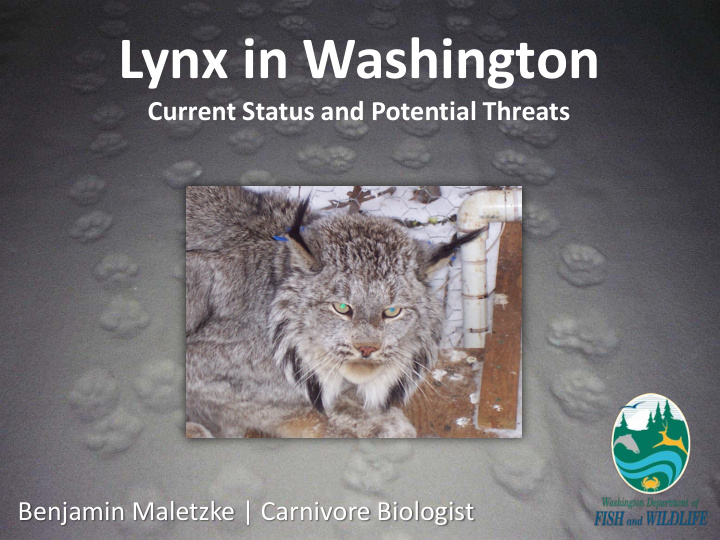



Lynx in Washington Current Status and Potential Threats Benjamin Maletzke | Carnivore Biologist
Historical Records of Lynx in Washington State Listed as Threatened in 1993 • Recovery Plan 2001 • No take or harassment • Management Plan • Stinson, D. W. 2001. Washington state recovery plan for the lynx. Washington Department of Fish and Wildlife, Olympia, Washington.
Lynx Surveys and Detections Survey Methods Track Surveys (WDFW, USFS, WDNR) • Remote Cameras (WDFW, WSU, UW) • Hair Snares (USFS, BLM, WDFW) • Trap Records (WDFW) • Verified Observations/Reports • Research (capture-collar/snow tracking) • Okanogan LMZ is only area with consistent reproducing population
Lynx Detections from 2005 – 2015
Research Lynx: Habitat, Home range, Density (Koehler and Brittell • 1990) Fine Scale Habitat Selection (Von Kienast 2003) • Statewide Habitat Model (Maletzke 2004) • Track surveys: 1987-present (USFS, WDFW, WDNR) • Habitat Connectivity (Vanbianchi and Hodges 2015) • Range and Density (Scully and Thornton ongoing) • Snowshoe hares: Habitat and Density (Koehler 1990) • Habitat Matrix and Density (Lewis • et al 2005, 2011)
The USFWS’s 5-factors for determining the need to list: Listing a Species Requirement for USFWS a. Present or threatened destruction of habitat or range b. Over-utilization c. Disease or predation d. Inadequacy of existing regulations e. Other natural or manmade factors affecting continued existence
Inadequacy of existing regulations ? Designated as Critical Habitat by USFWS
Disease or Predation? Disease? No documented cases in WA • Predation? 1 collared female killed by a cougar • Warmer drier winters (Climate Change) • Decreased snow pack and persistence • Snow conditions (freeze/thaw events = crust) •
Present or threatened destruction of habitat or range Bark Beatle Bud worm
>1,000 000 km 2 bur urned ed 1994-present
Present or threatened destruction of habitat or range ~ 2,600 km 2 in 1990 – 2002 < 1,600 km 2 in 2014
Natural or manmade factors affecting continued existence Climate Change Snow persistence (Spatial and Temporal) • Snow depth and condition • Interspecific Competition • Changes in Vegetation Cover • Temperature and precipitation driven • Fire Frequency, Intensity, and Size • Prey Density • Reduction and Isolation of suitable habitat •
Natural or manmade factors affecting continued existence Habitat Connectivity Okanogan ~ currently okay Fire? • Timber harvest? • Trapping in BC? • Kettle Crest Shrub-steppe? • Highway/Fence? • Kettle River? • Habitat in BC • Washington Wildlife Habitat Connectivity Working Group (WHCWG). 2010. Washington Connected Landscapes Project: Statewide Analysis. Washington Departments of Fish and Wildlife, and Transportation, Olympia, WA .
Natural or manmade factors affecting continued existence BC lynx harvest by management unit, 1985-2011 Trapping in Washington Not legal since 1991 • Live traps only for bobcat • Trapping in British Columbia, Canada Limiting potential immigration? • Trapping lynx emigrating from WA? •
Present or threatened destruction of habitat or range Regeneration after Wildfire 30% after 20 years • > 35 – 40 years for lynx • Vegetation shift (Climate change)? • Increase fire frequency and severity? • Thunder Mtn Burn - 1994
Potential Management and Recovery Actions: 1. Resume periodic surveys and monitoring with partners/collaborators 2. Revisit/review current management practices (WDNR, USFS, USFWS, Colville Tribe, others) to see if we can make them more friendly toward lynx 3. Probability of population persistence (Population Viability Analysis over 10, 25, and 50 years…) 4. Cooperation and collaboration with BC ~ (adapt to be sensitive to the concerns in Washington) 5. Evaluate the need and feasibility of augmenting female lynx in Okanogan LMZ? 6. Evaluate the need and feasibility of reintroducing lynx to the Kettle Crest? 7. Up listing lynx in WA to indicate the current status and severity of threats 8. Seeking partner collaboration and additional funding to support the actions listed above
Questions?
Current Surveys and Distribution Lynx Management Zone Surveys Conducted Detections Salmo Priest Track Surveys Occas. single tracks • Little Pend Oreille 20 remote cameras baited No Detections • w/roadkill deer Track Surveys Occas. single tracks • Kettle Crest 60 remote cameras No Detections • Track Surveys Occas. single tracks • Hair Snag Grid No Detections • Trap Records Last records ~ 1970’s • Vulcan – Tunk 16 Remote cameras No Detections • Track Surveys No Detections • Lake Chelan South Track Surveys No Detections • Okanogan Capture/Collar Effort Reproduction verified • Track Surveys Reproduction verified • 300+ Remote Cameras Reproduction verified • Trap Records Records through 1991 • Pasaytan Wilderness Camera 15 – 25% detection rate •
Recommend
More recommend